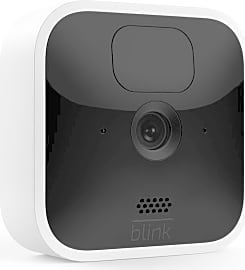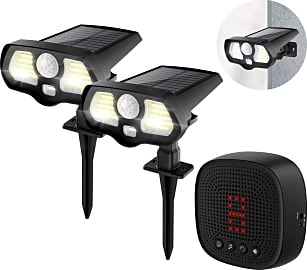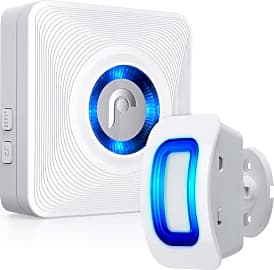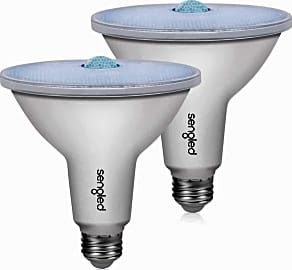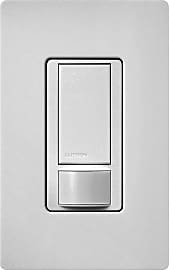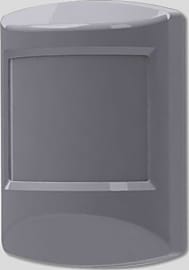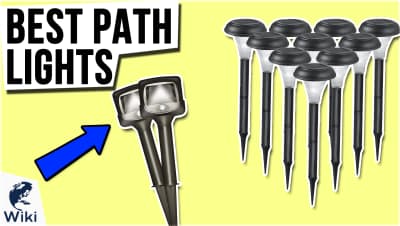The 10 Best Motion Sensors

This wiki has been updated 46 times since it was first published in April of 2015. Motion sensors help home and business owners automate their premises by activating lights automatically when someone approaches or by triggering alarms when a burglar breaks in. Our selections for this category include everything from basic models that require hardwiring through to smart wireless detectors that keep you advised of happenings via an app, even when you are away from home. When users buy our independently chosen editorial choices, we may earn commissions to help fund the Wiki.
Editor's Notes
November 30, 2020:
Although all of our previous picks for this category were still available and argubally good choices, a host of new offerings in the space still led us to rebuild much of our list, with our only remaining selections from last round being the Ecolink Z-Wave Plus, Kangaroo Home Security, Fosmon WaveLink 51005HOM and Canary All-in-One.
We replaced the Blink Home Security System with the Blink Indoor 2nd Generation – which features two-way audio functionality and an image resolution that’s been improved from 720p to 1080p – and switched the Chamberlain CWA2000 and Guardline Driveway Alarm out for the 1 By One Outside Property 6-SP07NA10-VC and Sgokeemn Alert System. Apart from finding our new picks to have much nicer designs, we also appreciated that they offered larger chime libraries – the Driveway Alarm has only 30, while the Outside Property has 36 and the Alarm System features 58 – and more opportunity for expansion — while the CWA2000 can only accommodate four sensors, the Outside Property can accommodate four zones, each with as many sensors, for a total of 16 units.
One standout feature offered by the Driveway Alarm, which we found difficult to come across elsewhere, is its receiver's built-in 12-volt relay. While the electrically inclined may find that this presents some interesting opportunities for expansion, we felt that this likely accounted for a small percentage of our users, and there were also some troubling reports of water damage on the Driveway Alarm’s sensor. On top of all this, we liked the way the Outside Property cleverly integrated its sensors into momentary solar path lights, leaving us with plenty of reasons to make these substitutions.
We also added three selections that we felt would be helpful for users looking to automate an existing light fixture. The first, the Lutron MS-OPS2, is essentially a standard decora light switch with a built-in motion sensor. It will require some hardwiring, which some homeowners may find intimidating (if you’re part of that population, we absolutely recommend consulting a reputable, licensed electrician to help ensure your peace of mind and safety), but others will find it quite manageable.
If you’d rather forego hardwired options altogether, our second and third modifying picks might be more up your alley. The second, the Lphumex G3373_AM, is a socket with a sensor that screws into an existing E26 or E27 socket, leaving you to screw a bulb of your choice into it. It features adjustable brightness and illumination-duration dials. The third, the Sengled Gen 4 SSP3891030G4WA, is even simpler, as it comprises a bulb with a built-in sensor, so you just need to replace your existing bulb and walk away. I like this last pick because it can easily be turned back to a constant-power light, simply by switching it off then back on.
Other options we eliminated were the Interlogix Indoor Wireless and Eaton Lighting MS180.
While we’ve got you here, perhaps you’ll be interested in checking out some of our related rankings, like Best Motion Lights, Best Hands-Free Kitchen Faucets and Best Motion Sensor Trash Cans.
December 18, 2019:
This round of updates, we removed the Doberman Security SE-0104, the Sadotech Wireless C Series and the Dome Home Automation DMMS1 – all due to availability issues. We also added several new options including the Eaton Lighting MS180 – a component that requires hardwiring but might stand to save you some money if you’ve got the know-how, the Fosmon WaveLink 51005HOM – a smart-looking sensor with 52 custom-chime options that makes a great alternative to a door bell, and the Kangaroo Home Security – a simple offering that can easily be fleshed out to a full home security system (with enough add-ons).
A few things to think about before you get moving on this purchase:
Purpose: In essence, a motion sensor is a fancy switch that changes positions when it senses motion. What you want that switch to power up is going to depend on your intended purpose. For example, the Eaton Lighting MS180 is a sensible option for controlling exterior lighting after dusk, but the Blink Home Security System is programmed to capture a short video anytime it detects somebody approaching your door. All this goes to say that, although our selections for this category are singular in their methodology, they differ in their purpose. So, make sure you pick the right one for your needs.
Connectivity: Several options we ranked, including the Chamberlain CWA2000 and the Fosmon WaveLink 51005HOM, are able to connect with additional sensors – allowing you to develop a monitoring network throughout your property, as far as their transmission range will allow. Other options, including the Blink Home Security System and the Honeywell Intrusion 5800PIR-RES, are compatible with smart home systems like Amazon Alexa.
Insurance: Although basic service through the Kangaroo Home Security app is available for free, they also offer a premium service for an annual fee that will afford you the peace of mind that comes with having your sensors professionally monitored. And, perhaps more importantly, it will also allow many homeowners to qualify for a reduced rate on their home-insurance premium. While we’re certainly not here to promote their service, if it’s a possibility that you think you might want to take advantage of in the future, then it might be a factor worth considering today.
History Of The Motion Detector
These waves had a standard pattern based on how the waves bounced off the inanimate objects.
Heinrich Hertz can be considered the pioneer of motion detection technology. He conducted experiments in the late 1900s that proved the existence of electromagnetic waves, including radio waves. In his experiments, he learned that these waves bounced of metal surfaces, dielectrics, and conductors and transmitted through other materials. Without these experiments, humans may never have developed radar technology, which is the basis of all early motion sensing systems.
In the early 20th century, German inventor Christian Hülsmeyer created a ship detection system to aid in maritime navigation, by using short bursts of radio waves to locate the metal makeup of ships. By using an oscilloscope to time the radio wave pulses, a ship's distance could be determined and, when coupled with an antenna that showed the ship's angular location, its location could be precisely positioned. This was the first true motion detection system.
Until the mid 1940s, when Samuel Bagno developed the first ultrasonic motion detector for use in home alarm systems, all motion detectors were radar-based and were used exclusively for military applications. Bagno's device was similar to radar-based motion detectors, except it made use of ultrasonic waves instead of radio waves. His motion detecting alarm created a grid of ultrasonic waves in a room. These waves had a standard pattern based on how the waves bounced off the inanimate objects. Any time something moved inside of the room, the pattern was disturbed, which triggered the alarm.
Bagno's ultrasonic alarm increased the demand for additional non-military motion sensor applications, which led to the invention of infrared motion detection, and paved the way for additional developments in other motion sensing technologies.
Types Of Motion Detectors
There are currently five distinct motion detection technologies; ultrasonic, microwave, passive infrared, tomographic, and camera-based.
Tomographic motion sensing systems perceive radio wave disturbances as they pass between a network's nodes.
Modern ultrasonic motion detectors use wave reflections off of inanimate objects to register movement by reading Doppler shifts in the frequency of said object. This allows it to detect whether an item is moving closer or farther away. Movement creates a heterodyne signal, which is registered by the sensor. The main downside to ultrasonic sensors is their ability to detect motion in areas where coverage isn't needed. Farther range on motion detectors in lights might not be a problem, but when it comes to automatic doors this can result in them opening at random times, even without the presence of a person.
Microwave motion sensors also use the Doppler principal, but make use of microwaves instead of ultrasonic waves. They send out a continuous microwave radiation signal and can measure phase shifts in the reflected waves as an object moves closer or further away. As with ultrasonic motion sensors, the heterodyne signal of the disrupted waves are detected and used to register movement. Microwave motion sensors are less susceptible to false alarms than ultrasonic detectors.
Passive infrared motion detectors work in a very different manner than ultrasonic or microwave sensors. Instead of measuring electromagnetic or sound waves they measure heat, and when it senses this emitted calefaction, it trips the alarm. Passive infrared sensors do not send out any energy, hence the name passive.
Tomographic motion detectors are rarely, if ever found in home motion detection alarm systems. They are better suited to larger applications that may include outside areas as well. Tomographic motion sensing systems perceive radio wave disturbances as they pass between a network's nodes.
Camera-based motion detection systems have the ability to sense motion by using computer software. This is how motion-activated security cameras know when it is time to start recording. They can be used in nighttime applications with the addition of near-infrared illumination.
The Value Of Home Security And Motion Detection
Far too often, people overlook or underestimate what home security measures should be taken to ensure their family and their belongings are safe. Not only can a home invasion or burglary lead to financial loss, it can lead to devastating emotional repercussions as well. It is common for someone who has been the victim of a home burglary to feel insecure in their home for a long period afterwards.
Oftentimes when people go out in the evenings, they may leave the front door light or the driveway light on so it will be easier to see when they return at night.
In 2014, there were over 8 million property crimes. In total, the victims of these crimes suffered billions in losses. Many of these crimes could have been avoided if the homeowners had a home security system. In fact, a 2009 study by Rutgers found that property crimes in neighborhoods decreased as the number of home security systems increased. Another study by the University of North Carolina found that over 30% of burglars would retreat when faced with a home security system.
In addition to safety, motion-detection systems can help people save money. Oftentimes when people go out in the evenings, they may leave the front door light or the driveway light on so it will be easier to see when they return at night. Installing a motion sensor, means that it will no longer be necessary to leave a light on for hours just to ensure visibility for a few minutes when returning home. Instead, the lights will automatically turn on when needed.
If one cannot afford a home security system, often just having outdoor lighting with motion sensing capabilities will be enough to deter a would-be burglar. If somebody is creeping around the outside of a home looking for an entry point, sudden illumination will usually be enough to scare them off.


